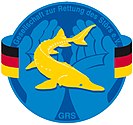Society for the rescue of the sturgeon
| Society for the rescue of the sturgeon e. V. (GRS) |
|
|---|---|

|
|
| founding | July 1st, 1994 in Senckenberg Research Institute in Frankfurt |
| founder | Eckhard Anders, Gerd-Michael Arndt, Lutz Debus, Jörn Gessner, Dietmar Firzlaff, Martin Hochleithner, Frank Kirschbaum, Toni Lelek, Harald Rosenthal, Jörg Schneider & Siegfried Spratte |
| Seat | Fischerweg 408, 18069 Rostock |
| main emphasis | Reintroduction of the sturgeon ( Acipenser sturio and Acipenser oxyrinchus ) |
| Action space | Germany |
| Chair | Jörn Gessner, Gerd-Michael Arndt, Siegfried Spratte & Carsten Kühn |
| Members | 40 |
| Website | sturgeon.de |
The Society for the Rescue of the Sturgeon e. V. (GRS) is a German association based in Rostock , which was founded on July 1, 1994 at the Senckenberg Research Institute in Frankfurt am Main . GRS is currently only open to specialist members. An amendment to the statutes to enable sponsoring memberships is being planned. The reintroduction of the sturgeon into Germany by GRS is one of the lighthouse projects of the Federal Agency for Nature Conservation (BfN).
background
The sturgeon populations indigenous to the North and Baltic Sea regions collapsed as early as the first half of the 20th century due to overfishing and cross-building of rivers. In 1993 a North Sea sturgeon ( Acipenser sturio ) was caught and sold to the canteen of the German Federal Ministry of the Interior , where it was consumed. A relic population of the Acipenser sturio that is presumably no longer viable in freedom exists today in the Gironde - Garonne system (last natural reproductions 1984, 1988, 1994, 1995).
As early as 1975, the French Institute de recherche en sciences et technologies pour l'environnement (CEMAGREF) began to examine this remnant and to make initial recommendations for the protection of the population. This was followed by efforts to multiply sturgeons in captivity and to use the offspring for stocking measures. An increase was achieved in 1995, 2007, 2008, 2009 and 2011.
Since the beginning of the 1990s, several associations and institutions in Germany have been trying to establish a species conservation program for the German river systems in cooperation with CEMAGREF . The Society for the Rescue of the Sturgeon was founded in 1994 to bundle these individual approaches.
Molecular genetic analyzes carried out on preserved tissue material in 2002 showed that the Baltic Sea region was inhabited by a second species, Acipenser oxyrinchus . Since then, the reintroduction attempts have also extended to this type.
aims
- Securing and protecting the remaining stocks of sturgeon in the North Sea ( A. sturio ) and Baltic Sea catchment areas ( A. oxyrinchus )
- The establishment of parent animal populations for controlled reproduction to preserve the species
- The preparation and implementation of reintroduction measures in their original distribution areas
Projects
- Acipenser sturio :
A group of soon sexually mature fish and young animals is held at the Leibniz Institute for Freshwater Ecology and Inland Fisheries (IGB) in Berlin. Young fish equipped with transmitters are released in the Elbe and its tributaries and tracked by telemetry in order to identify preferred habitats. If captive breeding succeeds, some of the young fish are released into the wild in the most suitable area.
- Acipenser oxyrinchus :
In 2005 suitable animals (100% genetic match with the extinct Baltic Sea population) were imported from the existing population in Canada. These animals are in Born a. Darß and held at the IGB. The first offspring have already been successfully bred in the Born facility. In 2012, up to 230,000 young sturgeon were released in the Oder and its tributaries. In addition, young fish with transmitters and marked sub-adult animals are regularly released into the wild in the Oder and neighboring Baltic Sea areas. Reports of recapture confirm that the animals are thriving well in the wild. In April 2013, another 200 sturgeons around 60 centimeters long and one year old were released into the wild near Hohensaaten (Brandenburg).
Since 2010 the company has been involved in a national resettlement program initiated by the Federal Ministry for the Environment, Nature Conservation and Nuclear Safety .
Web links
- Official website
- Project description at the Federal Agency for Nature Conservation ( Memento from October 29, 2013 in the Internet Archive )
- National action plan for re-naturalization (PDF file; 2.78 MB)
- Summary CITES sturgeon (English)
- CEMAGREF (French)
Individual evidence
- ↑ a b c Society for the rescue of the sturgeon - foundation. Retrieved October 11, 2019 .
- ↑ Perspectives for a reintroduction of the European sturgeon ( Acipenser sturio L., 1758) in the catchment area of the Rhine ( Memento from October 27, 2011 in the Internet Archive )
- ↑ Arne Ludwig, Lutz Debus, Dietmar Lieckfeldt, Isaac Wirgin, Norbert Benecke, Ingo Jenneckens, Patrick Williot, John R. Waldman, Christian Pitra: When the american sea sturgeon swam east . In: Nature . tape 419 , 2002, pp. 447-448 (English, abstract ).
- ↑ Gigantic effort for giants, RBB from June 6, 2011: OZON on the move. Retrieved October 11, 2019 .
- ↑ Experts relocate 200 sturgeons in the Oder. Spiegel Online , April 7, 2013, accessed October 11, 2019 .
- ^ Resettlement of the European sturgeon in Germany - National disturbance action plan published ( Memento from July 21, 2012 in the web archive archive.today ) Federal Ministry for the Environment, Nature Conservation and Nuclear Safety